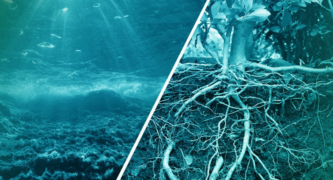As part of Conversations on Sustainability, a webinar series hosted by the Caltech Science Exchange, Dianne Newman, Gordon M. Binder/Amgen Professor of Biology and Geobiology and Ecology and Biosphere Engineering Initiative Lead for the Resnick Sustainability Institute; and Victoria Orphan, James Irvine Professor of Environmental Science and Geobiology and Allen V. C. Davis and Lenabelle Davis Leadership Chair of the Center for Environmental Microbial Interactions; discussed their research into the connections between microorganisms and climate change.
Orphan and Newman explain how microbes have shaped Earth to allow for complex life such as plants and animals, how microorganisms are adapting to the warming planet, and how humans might be able to use these organisms to help address climate change.
Here, they talk with Caltech science writer Lori Dajose (BS ’15).
The questions and answers below have been edited for clarity and length.
How have microbes influenced the evolution of life on Earth, and how have they influenced the planet?
Orphan: Microbes represent the earliest forms of life on our planet, emerging some 3.8 billion years ago. Over these billions of years, they‘ve shaped the chemical and physical environment in which we live, and they’ve paved the way for the evolution of multicellular life, like plants and animals.
These microbes are the champions of ecosystem engineering. One poignant example I can give you is the invention of oxygen photosynthesis. The ability to use sunlight to split water is important not only in the production of oxygen, which we all depend upon, but also because microbes are able to fix carbon dioxide [i.e., convert CO2 from the air into organic material]. In turn, this changed the total amount of biomass that could be sustained on Earth. All these processes, as well as the nutrients that these organisms are collectively cycling through their microscale ecosystems, are truly influencing our planet. They’re really our lifeline in creating an environment that is habitable for us.
Can each of you tell me a little bit more about your research focus? What kind of microbes do you study, and why?
Newman: Many in the audience might be familiar with thinking about the microbiome with respect to human health. Microbes play an equally important role in planetary health, and they’ve been doing this for billions of years, like Victoria said. There are so many aspects of this, but the part that intrigues me are the strategies that microbes use to conserve energy. I love this as a general topic because it reaches into every facet of life on the planet, not only human life but also the life of plants and other organisms.
What I try to do in my research is pick bacteria to study that have metabolisms that are very fundamental, that are as relevant in the context of soil as they are in chronic infection.
I always am reminding myself and my students of the fact that at the microbial scale, the microbe only knows what’s in its immediate surroundings. It’s possible to utilize methods of modern genetics to pick organisms that are important environmental organisms but nevertheless ones that we can bring into the laboratory, cultivate, and come to learn how they catalyze these remarkable processes that change their environment in profound ways. Our goal is to understand how they do that so that we can predict, in diverse contexts, what they will be doing and ultimately gain the ability to manipulate and control them toward good ends.
Orphan: My main interest is in microorganisms that live in ocean ecosystems. The oceans represent 71 percent of our planet’s surface, and the microbes that live in that environment are critical for controlling Earth’s climate and sustainability on the planet. It’s really quite shocking, given how big this ecosystem is and the impact that it has, that so little of the ocean environment has been studied by scientists—somewhere on the order of 5 percent. There are wonderful opportunities for new discoveries of microorganisms and their activities that can have profound impacts.
A lot of our research is conducted in deep-ocean environments, looking at the roles that microorganisms play in the methane cycle. Like carbon dioxide [CO2], methane is another greenhouse gas that is dynamically changing over time, and the oceans are a huge reservoir for methane. A lot of this is in the form of ice-like material rimming the continents. It’s known as methane hydrate, and very little of this methane gets released into the atmosphere because microorganisms are oxidizing this gas in sediments, basically serving as a biological filter. These organisms have been very difficult to culture in the lab, and we use combinations of molecular techniques like genomic sequencing and geochemical and isotopic analyses to study these microorganisms directly in the environment.
When most people think of microbes, they might think of the germs that make us sick. Why is it important to study microbes in the context of the broader biosphere and planet?
Newman: Yes, it’s a common misconception to think of microbes as pathogens. I think that is a vestige of the last century, when a lot of microbiology was oriented toward understanding how pathogens work. What we now know is that of the millions of microbial species on the planet, less than 100 are thought to be hardcore pathogens. That means the vast majority are doing things that are vital for the life of the planet and its habitats.
Orphan: Only recently—I think in large part due to the recognition that the human microbiome is important for human health—has the public has gained a greater interest in microorganisms and recognized that they are more than just pathogens to be feared. The fact that they are hard to see, yet they’re so pervasive and have such a profound impact, is one of the biggest challenges for us in terms of communicating to the general public that everybody should be paying attention to the microbial world. Our ability to understand biology in general, I think, is integrated with our understanding of microorganisms, simply because we’ve evolved in a microbial world. They were here on the scene billions of years before us.
Newman: Plants and animals did not evolve in a sea of Purell, right? We were surrounded by the microbial world from the get-go.
We now are seeing the effects of anthropogenic climate change—for example, sea-level rise, hotter and dryer conditions in some places, and ocean acidification. How have microbes been affected? Is there a danger that certain microbes will become extinct?
Orphan: I talked about my research in the deep sea. More recently, we have been working on coastal vegetated ecosystems, which include marine plants like seagrass that are huge sequesters of carbon and are also thought to buffer against some of the effects of ocean acidification. There is a lot of research to be done studying the fate of carbon within these ecosystems. Microbes play a central role in how much carbon is buried and how the health of these ecosystems is sustained. Understanding this is important with increasing impacts of climate change and rising CO2 in the atmosphere.
Newman: Another example is that we now appreciate that there’s a large amount of carbon stored in soil, but we don’t understand very well the mechanisms that enable it. We know that it involves a complex interrelationship between certain types of microbes such as fungi, which are associated intimately with nearly all plants on Earth. These fungi help provide plants with nutrients and water that allow them to thrive. But within the soil, there are many other kinds of microbes in addition to the fungi that form a community that makes the entire ecosystem whole. And so, one of the main interests for microbial ecologists is gaining a predictive understanding of how these ecological systems will evolve in different parts of the world. In the northern latitudes, a lot of carbon is stored in the frozen tundra, but as the planet is warming, the carbon stored in that soil will not necessarily stay there. But we are unable to predict what will happen because we lack a quantitative understanding of which organisms are present in this habitat, what they’re doing, and how they’re going to respond.
I once heard somebody say, “Microbes were the first in and are going to be the last out,” in terms of the life on this planet. I think that’s very profound and important for us to realize because microbes are always adapting at a pace that’s extraordinary. That’s something that potentially, if we understand it, can be leveraged for the human population.
What are some concrete ways that microbes can help us address sustainability and climate change?
Newman: There are so many examples. I’ll stick with my agricultural theme to give one: The over-utilization of fertilizer. Of course, crops need nutrients to grow, and we want crops to feed the global population. But what we don’t want is to waste nutrients like nitrogen or phosphorus because we run the risk of depleting natural reserves but also because we continue to generate nitrogen in fertilizer through industrial processes that themselves are environmentally harmful. So, there’s an incentive to think about how we might harness the microbial world’s natural ability to help crops gain these nutrients. It’s been known for many decades, for instance, that certain types of microbes have symbioses with certain types of crops. Soybeans are a good example: Bacteria in the soil can naturally take nitrogen from the atmosphere and convert it into a form that the soybean plant can use. If we understood how to effect that ability more broadly across a lot of different crops, that would be a game changer. That would give us an opportunity to have a much more sustainable source of nitrogen for crops.
Orphan: The same sort of thing applies in harnessing microbial activities in the ocean. Carbon sequestration is a big question, and people are working hard to try to figure out how to utilize microorganisms. I mentioned previously these vegetated coastal ecosystems where seagrass communities are huge storages of carbon. The plant basically fixes carbon dioxide through oxygenic photosynthesis, and a lot of that carbon ends up buried in the soil. We don’t fully understand the mechanisms that are driving that. A lot of it is done by microorganisms that don’t breathe oxygen but use a whole host of different chemicals to oxidize carbon. If we can understand the secrets to the success of how that carbon gets locked in, this is another opportunity for us to enhance further carbon burial in these coastal environments.
Here are some of the other questions addressed in the video linked above:
- Is there any evidence that microbes are mutating to thrive in higher CO2 concentrations?
- Is there research into genetically modified microbes for end goals like promoting photosynthesis or creating alternative foods?
- How far are we from knowing enough to be able to treat disturbed soils in specific land ecosystems to reestablish the right soil microbes and therefore optimize sequestering carbon with plant growth?
- How close are we to utilizing the metabolic processes you’re researching to do things like metabolize greenhouse gases, clean up oil spills, etc.?














 0 comments
0 comments


